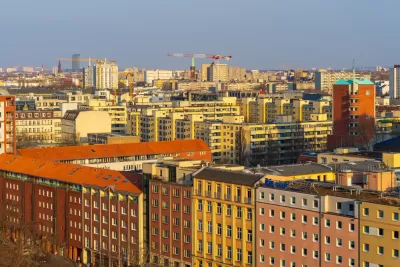More than half of Berlin voters approved a non-binding referendum to resocialize a quarter-million apartments. What can housing organizers in the U.S. learn?

At the end of September, Berliners went to the polls to vote for a new city and federal government. Their ballots included a controversial measure, Deutsche Wohnen Enteignen (Expropriate Deutsche Wohnen), calling for the socialization of the city’s largest landlords, who control about 10 percent (or 240,000 units) of the city’s housing stock. In a non-binding referendum, voters were asked if the city government should purchase the portfolios of landlords who own 3,000 or more apartments in Berlin. While the two most popular parties, the Social Democrats and the Greens, received 21.4 percent and 18.9 percent of the vote, respectively, most voters–56 percent–voted in favor of the referendum. Berliners are in much greater agreement over socialization than what the city’s next government should look like.
From a U.S. perspective, a successful campaign organized around housing socialization may seem like a difficult proposition. However, calls to reclaim grossly inflated real estate for the public good have recently become more prevalent in the United States, because U.S. cities are facing similar market pressures to Berlin’s. And, even though the socialization campaign is rooted in the particularities of German constitutional law and local political conditions, its underlying logic—that local governments should counteract aggressive speculative practices and act as a sort of anti-real estate state — is present in the work of U.S. based housing activists, from Oakland to Minneapolis to New York.
FULL STORY: 4 Lessons From Berlin Organizers’ Campaign to Re-Nationalize 250,000 Apartments

Planetizen Federal Action Tracker
A weekly monitor of how Trump’s orders and actions are impacting planners and planning in America.

Maui's Vacation Rental Debate Turns Ugly
Verbal attacks, misinformation campaigns and fistfights plague a high-stakes debate to convert thousands of vacation rentals into long-term housing.

San Francisco Suspends Traffic Calming Amidst Record Deaths
Citing “a challenging fiscal landscape,” the city will cease the program on the heels of 42 traffic deaths, including 24 pedestrians.

Defunct Pittsburgh Power Plant to Become Residential Tower
A decommissioned steam heat plant will be redeveloped into almost 100 affordable housing units.

Trump Prompts Restructuring of Transportation Research Board in “Unprecedented Overreach”
The TRB has eliminated more than half of its committees including those focused on climate, equity, and cities.

Amtrak Rolls Out New Orleans to Alabama “Mardi Gras” Train
The new service will operate morning and evening departures between Mobile and New Orleans.
Urban Design for Planners 1: Software Tools
This six-course series explores essential urban design concepts using open source software and equips planners with the tools they need to participate fully in the urban design process.
Planning for Universal Design
Learn the tools for implementing Universal Design in planning regulations.
Heyer Gruel & Associates PA
JM Goldson LLC
Custer County Colorado
City of Camden Redevelopment Agency
City of Astoria
Transportation Research & Education Center (TREC) at Portland State University
Jefferson Parish Government
Camden Redevelopment Agency
City of Claremont


























